Toxic algae blooms have been putting a damper on local summer fun this year — closing popular swimming areas like Vancouver Lake and warning people to keep themselves and their pets away from the water in Camas’ Lacamas and Round lakes.
Public health officials lifted the warnings at the Camas lakes earlier this week, just in time for the Fourth of July holiday, but that doesn’t mean we’re in the clear.
These algae blooms — really just eruptions of cyanotoxins that can kill pets and cause some pretty severe harm to humans’ kidneys, livers or nervous systems — are happening more often and in places that used to seem immune to such outbreaks.
Scientists have pointed to climate change as a contributing factor, stating that droughts, warmer lake waters and even torrential rainfall from changing weather patterns can all contribute to the increase in toxic algae blooms.
“We anticipate with warmer temperatures and longer summers … there is a greater chance that we’re going to see these organisms,” a Canadian cyanobacteria researcher told Canadian Broadcasting Corporation’s Information Morning show journalists in 2018.


